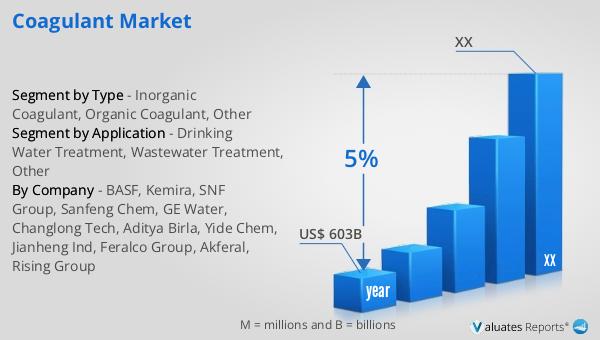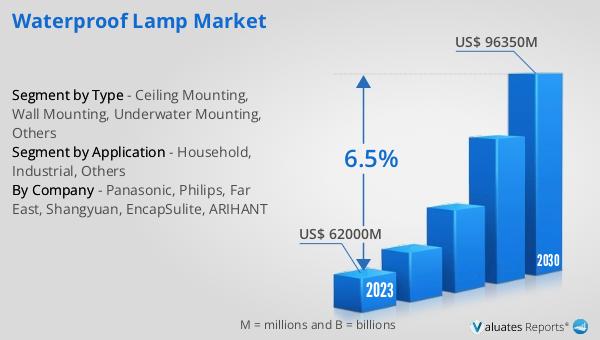What is Global Coagulant Market?
The Global Coagulant Market is a crucial segment within the broader chemical industry, primarily focused on substances that facilitate the coagulation process. Coagulants are essential in various water treatment processes, where they help in the aggregation of particles, making it easier to remove impurities from water. This market encompasses a wide range of products, including inorganic and organic coagulants, each serving specific purposes in different applications. The demand for coagulants is driven by the increasing need for clean and safe water, both for drinking and industrial purposes. As urbanization and industrial activities continue to rise globally, the pressure on water resources intensifies, thereby boosting the demand for effective water treatment solutions. The Global Coagulant Market is characterized by continuous innovation and development, as companies strive to create more efficient and environmentally friendly products. This market is also influenced by stringent environmental regulations and the growing awareness of the importance of sustainable water management practices. Overall, the Global Coagulant Market plays a vital role in ensuring the availability of clean water, which is essential for public health and industrial processes.

Inorganic Coagulant, Organic Coagulant, Other in the Global Coagulant Market:
In the Global Coagulant Market, coagulants are broadly categorized into inorganic coagulants, organic coagulants, and other types, each with distinct properties and applications. Inorganic coagulants, such as aluminum sulfate, ferric chloride, and polyaluminum chloride, are widely used due to their effectiveness in destabilizing and aggregating suspended particles in water. These coagulants work by neutralizing the negative charges on particles, allowing them to clump together and form larger aggregates that can be easily removed through sedimentation or filtration. Inorganic coagulants are particularly effective in treating raw water with high turbidity and are commonly used in municipal water treatment plants. However, they can sometimes lead to the production of sludge, which requires proper disposal and management. On the other hand, organic coagulants, such as polyamines and polyDADMAC, are gaining popularity due to their lower sludge production and higher efficiency in certain applications. Organic coagulants are often used in combination with inorganic coagulants to enhance the coagulation process and improve the overall quality of treated water. They are particularly effective in treating water with low turbidity and are often used in industrial water treatment processes. Additionally, organic coagulants are biodegradable and have a lower environmental impact compared to their inorganic counterparts. The "other" category in the Global Coagulant Market includes hybrid coagulants and natural coagulants. Hybrid coagulants are a combination of inorganic and organic coagulants, designed to leverage the benefits of both types. They offer improved performance and reduced sludge production, making them an attractive option for various water treatment applications. Natural coagulants, derived from plant or animal sources, are also gaining attention due to their eco-friendly nature and potential cost-effectiveness. These coagulants are particularly appealing in regions with limited access to conventional chemical coagulants. Overall, the choice of coagulant depends on several factors, including the characteristics of the water to be treated, the desired quality of the treated water, and environmental considerations. The Global Coagulant Market is continuously evolving, with ongoing research and development efforts aimed at creating more efficient and sustainable coagulant solutions.
Drinking Water Treatment, Wastewater Treatment, Other in the Global Coagulant Market:
The Global Coagulant Market finds extensive usage in various areas, including drinking water treatment, wastewater treatment, and other applications. In drinking water treatment, coagulants play a critical role in ensuring the safety and quality of the water supply. They are used to remove suspended particles, organic matter, and microorganisms from raw water, making it safe for human consumption. The coagulation process is typically followed by sedimentation and filtration, which further enhance the clarity and purity of the treated water. In this context, both inorganic and organic coagulants are used, depending on the specific requirements of the water treatment plant and the characteristics of the raw water. Wastewater treatment is another significant area where coagulants are extensively used. In this application, coagulants help in the removal of pollutants, such as heavy metals, phosphates, and organic compounds, from industrial and municipal wastewater. The coagulation process is crucial in reducing the environmental impact of wastewater discharge and ensuring compliance with regulatory standards. In wastewater treatment, the choice of coagulant depends on the nature of the pollutants present and the desired level of treatment. In addition to drinking water and wastewater treatment, coagulants are also used in various other applications, such as paper and pulp manufacturing, mining, and oil and gas production. In the paper and pulp industry, coagulants are used to improve the efficiency of the papermaking process by enhancing the retention of fibers and fillers. In mining, coagulants are used to treat process water and tailings, reducing the environmental impact of mining operations. In the oil and gas industry, coagulants are used to treat produced water and enhance the efficiency of oil recovery processes. Overall, the Global Coagulant Market plays a vital role in various industries, contributing to environmental sustainability and public health. The demand for coagulants is expected to continue growing as industries and municipalities seek more efficient and sustainable water treatment solutions.
Global Coagulant Market Outlook:
Based on our analysis, the worldwide market for medical devices is projected to reach approximately $603 billion in 2023, with an anticipated growth rate of 5% annually over the next six years.
| Report Metric | Details |
| Report Name | Coagulant Market |
| Accounted market size in year | US$ 603 billion |
| CAGR | 5% |
| Base Year | year |
| Segment by Type |
|
| Segment by Application |
|
| Consumption by Region |
|
| By Company | BASF, Kemira, SNF Group, Sanfeng Chem, GE Water, Changlong Tech, Aditya Birla, Yide Chem, Jianheng Ind, Feralco Group, Akferal, Rising Group |
| Forecast units | USD million in value |
| Report coverage | Revenue and volume forecast, company share, competitive landscape, growth factors and trends |
